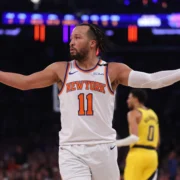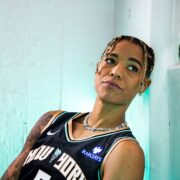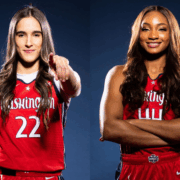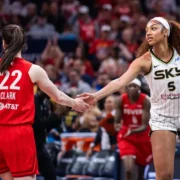Why Are WNBA Stars Still Earning Fast Food Wages While the League Booms?
The WNBA is in the middle of a glow-up. Viewership is skyrocketing, merch is selling out, and names like Caitlin Clark, Angel Reese, and Paige Bueckers are trending every week. Social media is flooded with highlights. Fans are locked in. Brands are finally investing.
And yet, somehow, the league’s top draft pick will earn… $76,535.
That’s not a typo. That’s the base salary for the No. 1 overall pick in the 2025 WNBA Draft—likely to be Caitlin Clark, a generational talent whose college games were drawing Super Bowl numbers. In the NBA, the No. 1 pick last year signed a four-year, $55 million deal. Same draft energy. Vastly different checks.
So yeah, the WNBA is growing. But the money? Not so much. And the players are done playing nice about it.
“You Can’t Build the Future of the League and Be Broke Doing It”
The numbers tell the story: WNBA players receive just 9.3% of the league’s revenue. Compare that to NBA players, who rake in nearly 50% through their collective bargaining agreement. That massive difference is why rookies in the NBA are millionaires overnight, while their W counterparts are essentially working-class athletes—despite being the ones fueling the league’s growth.
WNBA players have been making noise about this for years. But now that the talent and popularity are undeniable, their push for higher pay has become a rallying cry for fans, media, and players alike.
“It’s not even about being rich,” said Napheesa Collier, WNBA All-Star and union VP. “It’s about fairness. We’re the product. We’re driving engagement. We deserve to be invested in.”
Caitlin Clark’s Value Is “Unmatchable”—Literally
Clark, who will likely be the Indiana Fever’s top pick, is walking into a league where she’ll instantly be one of its biggest stars. According to her agent, CAA’s Erin Kane, her “value simply can’t be matched” by the current salary structure.
And they’re right. Clark was reportedly offered $1 million to play in Unrivaled, a new 3-on-3 offseason league led by W stars Breanna Stewart and Collier. She turned it down to stay committed to the WNBA, even though it would’ve been nearly 13x her rookie salary.
That alone shows the loyalty players have to the league. But at what cost?
“These women shouldn’t have to choose between staying in the league they built and earning what they’re actually worth,” said ESPN analyst Andraya Carter. “We talk about growing the game—this is part of that growth.”
The “Exposure” Argument Is Getting Old
For years, the league leaned on the idea that players should be grateful for visibility. That exposure was the trade-off for lower salaries. But in 2025, with multimillion-dollar media deals and millions of fans tuning in, that argument just doesn’t hold.
In February, the WNBA landed a $2.2 billion broadcast deal set to kick in with the 2026 season. It’s a massive win that should—should—trickle down to the players. But until that check clears, athletes are left patching together income from overseas contracts, brand deals, and side hustles just to make a living.
In any other profession, being elite doesn’t require moonlighting.
The Unrivaled League Is Sending a Loud Message
Enter: Unrivaled—the new player-founded 3-on-3 league that’s offering short-season play and six-figure paychecks.
It’s a big middle finger to the WNBA’s slow pace on compensation, and a powerful example of what players can build on their own terms. Players like Angel Reese and Kelsey Plum thrived in it this past offseason. Reese was even named Defensive Player of the Year, cementing her offseason as one of pure evolution.
Clark turning down a million-dollar offer to stay WNBA-focused sent a message. But Unrivaled’s existence also sends one: There’s a growing ecosystem that will pay women what they’re worth. If the W can’t match that energy, players will find other ways to thrive.
What’s the Hold Up?
To be fair, the WNBA is still operating under its 2020 Collective Bargaining Agreement (CBA), which raised the salary cap and introduced things like paid maternity leave, travel upgrades, and performance bonuses. It was progress. But now, five years later, the league has changed dramatically—and the CBA hasn’t caught up.
The next round of negotiations will be critical. Players like Collier and Stewart are already hinting at a push for a more NBA-style revenue share. And with the league’s next media deal looming large, they have real leverage for the first time in a long time.
There’s also the looming possibility of a lockout if progress stalls. It’s not something anyone wants, but it’s on the table.
“If You Want the Spotlight, You Gotta Pay for It”
There’s something kind of ironic about it all. The league is finally getting the attention it deserves—celebrities in the crowd, sellout games, viral moments—and now it risks losing momentum if it doesn’t invest in its biggest assets: the players.
People aren’t tuning in just for logos. They’re showing up for Clark, Reese, Bueckers, Stewart, Ionescu, Wilson. The personalities, the skill sets, the rivalries—they’re the engine. And you don’t let your engine run on fumes.
“We’re not just athletes,” said A’ja Wilson last year. “We’re culture.”
She’s not wrong. And if the WNBA wants to build a league that matches that culture, the money has to match the moment.
TL;DR? Pay the Players
Let’s keep it real: nobody’s asking for WNBA rookies to be billionaires. But in a league built on excellence, sacrifice, and undeniable cultural relevance, it’s time the paychecks started reflecting the work.
Because when your top players are out here building empires off the court, selling out arenas on it, and still making less than an NBA trainer, it’s not just frustrating—it’s embarrassing.
The next generation of hoopers is watching. The fans are watching. The world is watching.
And the question is simple:
If the WNBA is ready for its next chapter, is the pay structure ready too?






